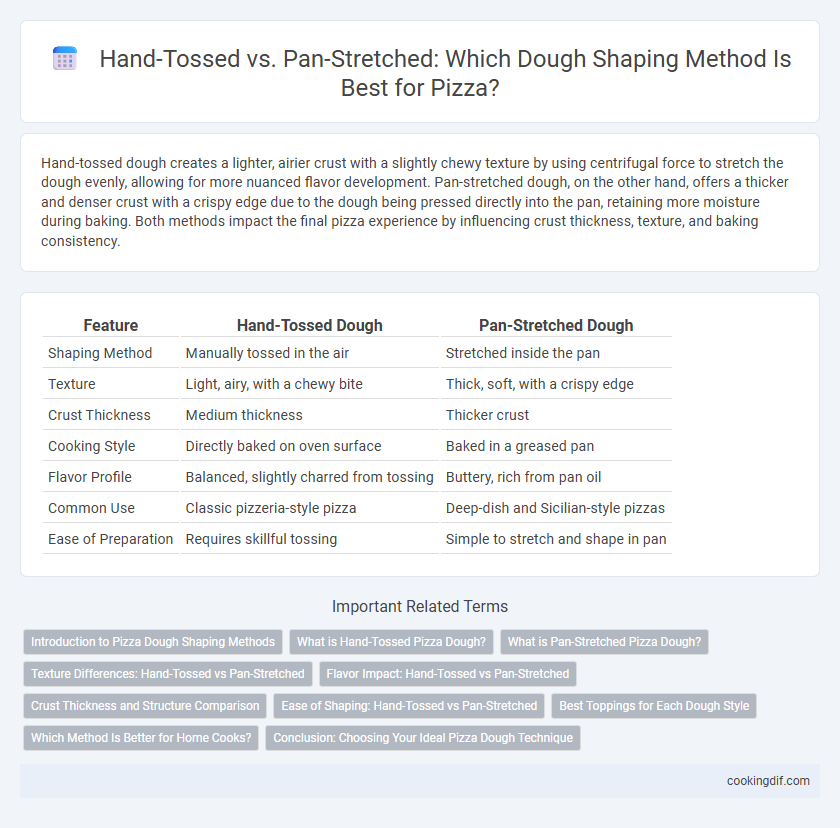Hand-tossed dough creates a lighter, airier crust with a slightly chewy texture by using centrifugal force to stretch the dough evenly, allowing for more nuanced flavor development. Pan-stretched dough, on the other hand, offers a thicker and denser crust with a crispy edge due to the dough being pressed directly into the pan, retaining more moisture during baking. Both methods impact the final pizza experience by influencing crust thickness, texture, and baking consistency.
Table of Comparison
| Feature | Hand-Tossed Dough | Pan-Stretched Dough |
|---|---|---|
| Shaping Method | Manually tossed in the air | Stretched inside the pan |
| Texture | Light, airy, with a chewy bite | Thick, soft, with a crispy edge |
| Crust Thickness | Medium thickness | Thicker crust |
| Cooking Style | Directly baked on oven surface | Baked in a greased pan |
| Flavor Profile | Balanced, slightly charred from tossing | Buttery, rich from pan oil |
| Common Use | Classic pizzeria-style pizza | Deep-dish and Sicilian-style pizzas |
| Ease of Preparation | Requires skillful tossing | Simple to stretch and shape in pan |
Introduction to Pizza Dough Shaping Methods
Hand-tossed and pan-stretched are two popular pizza dough shaping methods that influence crust texture and flavor. Hand-tossed dough is stretched by spinning and tossing, resulting in a lighter, airier crust with slightly crispy edges. Pan-stretched dough is pressed and shaped directly in the pan, producing a thicker, chewier crust with a crisp bottom ideal for deep-dish or pan-style pizzas.
What is Hand-Tossed Pizza Dough?
Hand-tossed pizza dough is prepared by skillfully spinning and stretching the dough in the air, creating an evenly thin and airy crust with a slight chewiness. This traditional technique allows for better air circulation and a lighter texture compared to pan-stretched dough, which is pressed directly into a pan for a denser, thicker crust. The hand-tossing method enhances the dough's elasticity and helps develop a balanced combination of crispiness on the outside and softness inside.
What is Pan-Stretched Pizza Dough?
Pan-stretched pizza dough is shaped directly in the baking pan, allowing the dough to rise and develop a thicker, softer crust with a slightly crispy edge. This method contrasts with hand-tossed dough, where the dough is stretched by hand to a thinner, more even thickness before baking on a stone or screen. Pan-stretching produces a chewier texture and often results in a more airy and golden-brown crust due to the dough's contact with the oiled pan.
Texture Differences: Hand-Tossed vs Pan-Stretched
Hand-tossed pizza dough features a light, airy texture with a slightly crispy crust due to the spinning and stretching technique that incorporates more air. Pan-stretched dough results in a thicker, denser crust with a soft, chewy interior and crisp edges from the oil-coated pan baking method. Texture differences significantly influence pizza mouthfeel, affecting customer preference between the traditional, airy hand-tossed and the hearty, golden pan-stretched styles.
Flavor Impact: Hand-Tossed vs Pan-Stretched
Hand-tossed pizza dough develops a lighter, airier texture with subtle charring that enhances the flavor through caramelization during baking, creating a slightly smoky and crisp crust. Pan-stretched dough yields a denser, chewier crust with a buttery, richer taste due to oil absorption in the pan, resulting in a golden, crispy bottom layer. Flavor profiles differ as hand-tossed emphasizes crispness and slight smokiness, while pan-stretched offers a soft interior with a pronounced buttery, toasted flavor.
Crust Thickness and Structure Comparison
Hand-tossed pizza dough typically features a thinner, airier crust with a chewy texture due to the stretching process that incorporates more air bubbles. Pan-stretched dough results in a thicker, denser crust with a crispier bottom, as the dough rests and expands in the pan, allowing for a more uniform thickness. The structural difference lies in hand-tossed crusts being lighter and more flexible, while pan-stretched crusts offer a hearty, bread-like bite.
Ease of Shaping: Hand-Tossed vs Pan-Stretched
Hand-tossed pizza dough is easier to shape due to its elasticity, allowing for quick stretching and a thin, airy crust. Pan-stretched dough requires uniform pressure and patience to avoid tearing, often resulting in a thicker, chewier base. Choosing between the two depends on desired crust texture and dough handling experience.
Best Toppings for Each Dough Style
Hand-tossed pizza dough, known for its thin, crispy edges and chewy center, pairs best with light toppings like fresh mozzarella, basil, cherry tomatoes, and olive oil to enhance its airy texture. Pan-stretched dough, thicker and crispier with a bready base, holds up well to hearty toppings such as sausage, pepperoni, mushrooms, and caramelized onions, offering a balanced bite with rich flavors. Choosing toppings based on dough style maximizes taste and texture harmony in every slice.
Which Method Is Better for Home Cooks?
Hand-tossed dough offers a light, airy crust with a slightly chewy texture, ideal for those who prefer a more traditional pizza experience, while pan-stretched dough yields a thicker, crispier base with a buttery finish perfect for hearty toppings. Home cooks benefit from pan-stretched dough due to its ease of shaping and consistency without requiring advanced tossing skills. Choosing between these methods depends on desired crust texture and personal comfort with dough handling techniques.
Conclusion: Choosing Your Ideal Pizza Dough Technique
Hand-tossed dough offers a lighter, airier crust with a traditional texture, ideal for those who prefer a chewy bite and crispy edges. Pan-stretched dough yields a thicker, denser base that holds more toppings and delivers a buttery, golden crust. Selecting your ideal pizza dough technique depends on your preference for texture, crust thickness, and topping capacity, ensuring a personalized pizza experience.
Hand-tossed vs Pan-stretched for dough shaping Infographic

 cookingdif.com
cookingdif.com